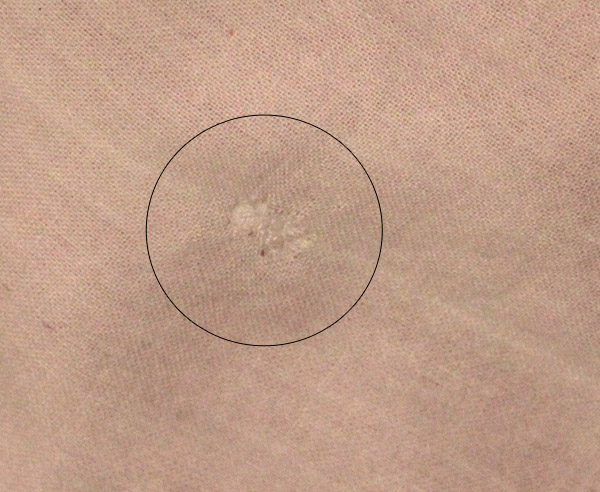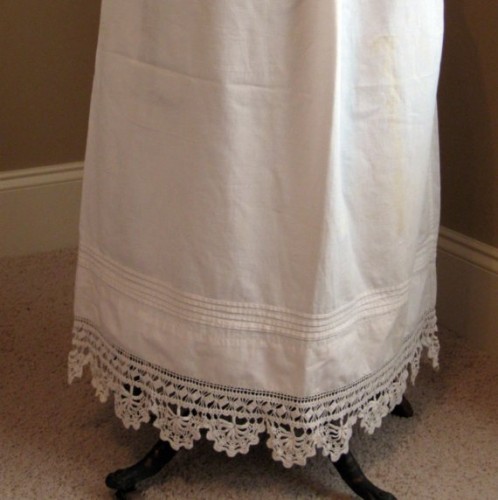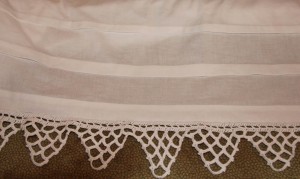Aprons, Part 2
April 25th, 2012
I promised to share more from my new wealth of aprons, so here goes. The two I’ve picked today are fairly new — based on fabric and style I’d guess no earlier than late 1960s, possibly as recent as the 1980s. What makes them particularly useful is that they both incorporate hand towels.

See the little pink towel sewn into the waistband? I’ve been known to shove a towel into the waistband of my apron or even my clothing while I cook. Or else tear the kitchen apart frantically searching for the towel I just put down. What convenience to have one built into your apron!
This next one, which I’ve already worn for a few sessions of housework, takes it a step further.

It IS a towel. With a pretty blue binding and waistband to turn it into an apron. It may not be the most fashionable garment on the face of the earth, but it’s cheerful, cute, and oh so handy to have around your waist!
Aprons, Part 1
April 23rd, 2012
We’ve been here in our new home for nearly four months now, yet still have mountains of boxes to open and sort. You’d think it would be easy since our last 10 years were spent in a garret. I mean, how much stuff can you fit in 250 square feet? You’d be surprised. Add to that the contents of my mother’s attic, including boxes and boxes of lavish wedding presents we couldn’t squeeze into our apartment so never got to use (think stainless fondue service for eight and imported Italian pasta maker), plus a number of treasured heirlooms from my maternal grandmother, a few from the paternal side, and you’ve got a pretty big pile.

A day or two ago I ran into a lifetime supply of aprons from my grandmother. Counting handful I already owned, I think I’ve now got about 20. And I plan to wear them. Well, some of them. This one, for example, is both too fragile and too special to risk soiling. First of all, it’s handmade. Machine sewn, but the tension is a bit wonky in places making it less than durable. The material is also rather weak. Notice the tear on the left side (your right as you look at the picture).
But more importantly, according to the note I found in the pocket, it was made for my grandmother by her mother-in-law, my great grandmother.

I’ll share more vintage aprons, from the 40s through the 70s, in coming posts.
Darn It
November 1st, 2011
The last time I wore my favorite chemise, I noticed yet another tiny rip. So after washing it, I hung it up to remind myself to mend it. That was in early September. Yesterday morning, right before I needed to wear it again, I finally got around to fixing the hole.
This one was too small to bother patching, so I decided to try my hand at darning. Lacking proper darning thread, and working against the clock, I did it rather sloppily. It’s also really hard to see when you’re weaving thread over other thread!

It may not be pretty, but it’s barely noticeable when it isn’t magnified. And it certainly does the trick! I need to learn more about darning — and of course, practice, practice, practice.
Hemming & Hawing
September 23rd, 2011
I’ve just finished hemming a pair of pants for my husband’s new (blond corduroy!) suit. I did it in the nick of time too, so that he can look dashing at our friend’s daughter’s Bat Mitzvah tomorrow morning. As I stitched, I thought about another hem that’s been bothering me. Namely, the incorrect hem I put into my last petticoat, the one to which I attached my first crocheted edging.
Instead of a wide skirt hem, I did a one inch number, cleverly disguised as the third tuck. Then I whipped on the trim. I had a feeling that this was all wrong while I was doing it, but couldn’t find any actual evidence to support my vague suspicions. And since I had been a little chintzy when cutting my breadths for the petticoat, I was afraid there wouldn’t be sufficient turn-down at the top for balancing and went with the slim hem to be safe.
But earlier this week I found proof that I would have done better to risk a wider hem. More like three or four inches instead of one.


The web site selling both of these petticoats identifies them as late-19th century. But they could easily have been remodeled from earlier petticoats and/or petticoat trim. The first one looks mid-century in construction even, if you ask me. I’m less sure about the second, partly due to its narrow width, and partly for the pin tucks which I’ve never seen on a mid-century petticoat — not that that means anything. Regardless of their vintage, notice how they each have the crochet trim or inserting attached to a nice wide hem. Alas!
I’m far too lazy to make a new petticoat skirt for my finished edging. It will just have to languish in its anachronistic state. As reenactors are fond of saying in defense of their irregular underwear, anyone looking close enough to see the mistakes deserves what they get. But I do intend to do a better job for my current edging. I’m also toying with the idea of attaching it to an embroidered petticoat. Though I’d like to find a precedent for such double decoration first.
Another Down
September 7th, 2011
This morning I woke up early and finished whipping the edging onto my new petticoat. It’s now resting, neatly folded, next to my embroidered petticoat. Both are awaiting waistbands, which I can’t attach until I assemble my cage…
I am resisting the urge to embroider this one. I can’t help seeing where a pair of inserting patterns, between the tucks, would be a lovely addition. But the fabric is so lousy — hardly worth putting more time into it. And, truth be told, embroidery might be overkill with the heavy crochet work.
Now, on to my day!
« Newer Posts — Older Posts »
